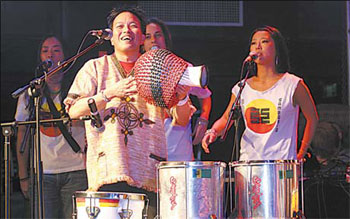|

Jimmy Biala performing with members of SambAsia. Xie Yu
|
"The idea was based on fostering a sense of one world awareness, of sharing and finding a common human ground through music and dance. Our ensembles are based upon the model of the samba schools of Rio de Janeiro and the Afoxe groups of Salvador, Bahia, Brazil. The music and dance brings people together across cultural and generational lines," Biala says.
In Brazil, everyone loves samba, it's a birthright, something that brings people together. People hear it and they follow. It is also amazingly flexible. It can be a parade song pounded out by thousands of people in a carnival procession, or it can be an intimate ballad. It can be a love song, a proclamation of local pride, an exploration of nostalgia, or a subtle protest. It can be a pop song, a jazz exploration or an Afro-Brazilian celebration.
In accordance with tradition, SambAsia's percussion group uses four different types of drums, and also incorporates singing and dancing from Brazil. By 2005, the San Francisco drumming group had more than 100 members, and Biala brought it to Beijing in May 2006.
Since being founded in Beijing, SambAsia Beijing has expanded from a core group of 15 people to a community ensemble of over 40, offering several different levels of classes in Brazilian percussion and dance.
"It can be crazy during the week. Playing drums in the community fulfills and completes our life," says Zoe, one of its members. Some of its members even want to quit their day jobs and devote their lives to SambAsia Beijing.
"One of my colleagues is a member of SambAsia Beijing. With his encouragement, I joined the team," Wang Weiyi, who joined the team in December 2006, recalls. "It was not difficult to learn drumming and practicing is necessary. Learning, practicing and rehearsing are pure fun at the beginning, which I looked forward to everyday. I make new friends there as well. Gradually, the drum thing became my habit and makes me happy. I know I am in love with it."
Wang says she never feels conservative and nervous on the stage because there are her team members along with her. She also hopes they can play drum on a beach someday. "Barefoot on soft sand with sunshine and sea, it must be exciting to drum there."
Members say that practicing can be a little bit boring and tired at the beginning. But the whole learning process relieves pressure from everyday work and the sound of drum brings a different world.
"Having audiences get involved gives us sense of achievements, though we are not professional. It is happy to watching them dancing to our drumbeat," Wang says.
Big things have been happening in the past few months that have amazed the team. From performing on Beijing's rock stages, at art festivals and private events like shopping mall openings, they have become hot property.
SambAsia opened for Cui Jian's 20-year retrospective concert in January at the Worker's Gymnasium and has been endorsed by the Brazilian embassy. Most recently, SambAsia received an official invitation from the Brazilian state of Bahia to participate in this year's Carnival and has just returned to Beijing.
"SambAsia Beijing is a good representative and serves as a bridge between different cultures," says Celso Franca, first secretary at the Brazil Embassy in China.
SambAsia Beijing is still looking for new members for its workshops.
"We have members from China, Canada and the US and there is no language barrier at all. I think it is the drum and music that connect us together, keeping us inspired," Biala says.
(China Daily February 28, 2008)